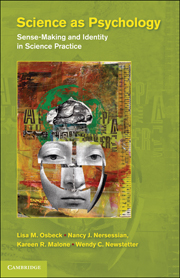Book contents
- Frontmatter
- Contents
- Acknowledgments
- 1 Introduction: Science and Persons
- 2 Methods of Study
- 3 The Problem-Solving Person
- 4 The Feeling Person
- 5 The Positioning Person
- 6 The Person Negotiating Cultural Identities
- 7 The Learning Person
- 8 Epilogue: Science as Psychology: A Tacit Tradition and Its Implications
- References
- Index
5 - The Positioning Person
Published online by Cambridge University Press: 05 July 2011
- Frontmatter
- Contents
- Acknowledgments
- 1 Introduction: Science and Persons
- 2 Methods of Study
- 3 The Problem-Solving Person
- 4 The Feeling Person
- 5 The Positioning Person
- 6 The Person Negotiating Cultural Identities
- 7 The Learning Person
- 8 Epilogue: Science as Psychology: A Tacit Tradition and Its Implications
- References
- Index
Summary
INTRODUCTION: IDENTITY AND PSYCHOLOGY
In the previous chapter we examined emotion in terms of sense-making because of its intricate interrelation with cognitive practices evidenced in the laboratories. We now turn to a topic closely related to emotion: identity. Like emotion, the topic of identity is critical to any focus on the acting person, the central unit of analysis we embrace. In contemporary theory identity frequently emerges as a form of action, accomplishment, display, or performance situated within networks of meanings and practices; people identify as or with various options. Because performances are many and varied, the term “identities” might be more accurate to the subject matter.
As was the case for emotion, this subject matter is vital to our interest in avoiding both social and cognitive reductionism in analyzing the practices of the biomedical engineering laboratory communities. Wenger, for whom identity is of central concern in Communities of Practice (1998), noted that “the concept of identity serves as a pivot between the social and the individual, so that each can be talked about in terms of the other. It avoids a simplistic individual-social dichotomy without doing away with the distinction…it is the social, the cultural, the historical with a human face” (Wenger, 1998, p. 145). Even more strongly, he argued that “the formation of a community of practice is also the negotiation of identities” (p. 149).
- Type
- Chapter
- Information
- Science as PsychologySense-Making and Identity in Science Practice, pp. 120 - 156Publisher: Cambridge University PressPrint publication year: 2010



